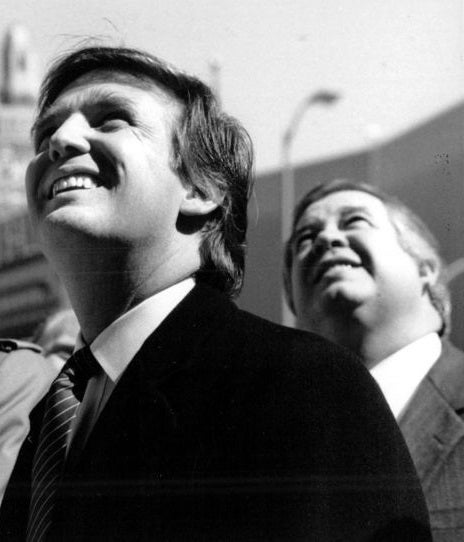
Donald Trump and Stephen Hyde at the March 20th, 1987 topping-off ceremony for the Trump Plaza Hotel and Casino in Atlantic City.
Just two months ago, Michael Kranish and Marc Fisher, two Washington Post reporters, published a biography of Trump, Trump Revealed, for which the current GOP presidential candidate had supplied 20 hours of interviews. In the book, presumably intended by the candidate to bolster his then-slumping campaign, Trump details for Kranish and Fisher his 1989 reaction to the death by helicopter crash of three Trump executives: Mark Etess, Jonathan Benanav, and Stephen Hyde, a Mormon father of seven who was considered the mastermind of Trump’s Atlantic City casino empire and was, at the time of his death, the president of the Trump Plaza Hotel and Casino. According to The New York Times, Hyde was “an active member of a small local congregation of the Church of Jesus Christ of Latter-day Saints ... and commanded the highest respect among religious and business peers.”
For years, Trump has insisted that he was slated to be on Hyde’s helicopter on the day it crashed—in fact, he told CNN at the time that it was “like a fifty-fifty deal”—and in Kranish and Fisher’s August-published biography he expanded significantly on that claim, saying that his phone call to the families of Etess, Benanav, and Hyde after the crash was the equivalent of a military official (or, in an implication Trump would surely welcome, the president of the United States), calling “soldiers’ families when they’re gone.” Whether Trump repeated his claim that he nearly died with Hyde and the others in speaking to their families is currently unknown—as no one appears to have asked either Trump or the families themselves.
The problem with Trump’s account, whether or not it was shared privately as well as with numerous national media outlets, is that there’s significant evidence to suggest that it’s false.
As Andrew Kaczynski and Mark Acre of Buzzfeed have reported, three biographies of Trump—all citing multiple sources—allege that not only was Trump never slated to be on the helicopter on which Hyde and the others later died, he in fact deliberately exploited Hyde’s death as part of a ploy to build publicity and generate profit for himself and his companies.
According to Harry Hurt’s Trump biography Lost Tycoon, after being asked by a reporter, hours after the accident, to comment, via telephone, on the fatal crash that killed Stephen Hyde and several others, Trump muted the line and then said to the several high-level Trump staffers assembled before him, “You’re going to hate me for this, but I just can’t resist. I can get some publicity out of this.”
Switching the line back on, Trump issued for the first time a story that he’s stuck with all the way through this presidential election: “You know, I was going to go with them on that helicopter.” This claim, and the vague narrative details Trump subsequently appended to it in that interview and as recently as August 2016, were soon being reported by news outlets including The New York Daily News, The Philadelphia Inquirer, and UPI. In some instances unnamed “sources” were quoted for the proposition that Trump had nearly died alongside Hyde, while in others either Trump himself or sources close to him (for instance, Dan Klores, his then-spokesman) were cited.
The Lost Tycoon cites, according to Buzzfeed, “half a dozen bona fide sources close to Trump” who insist that Trump’s sensational brush-with-death story was and remains “a barefaced lie.” Not only did Trump travel exclusively, at that time, on his personal Super Puma helicopter, he also, according to Hurt, had a meeting scheduled for that afternoon which would have precluded him from being on the fatal flight.
A similar (and similarly well-sourced) debunking of Trump’s claim can be found in Wayne Barrett’s The Deals And The Downfall, and then again, in some detail, in John R. O’Donnell’s Trumped! Even an Associated Press story that ran at the time quoted Bernie Dillion, a vice president of Trump Sports and Entertainment, as saying that “Trump had definitely never planned to be on [Hyde’s helicopter].”
As Trump frantically woos Mormon voters in Utah—challenged there from both the Democratic Clinton and the Independent (and Mormon) Evan McMullin, the latter of whom leads both Trump and Clinton in several recent polls of the state—it’s not clear whether Trump’s ongoing (as recent as August) exploitation of the death of one of his top executives will hurt him at the polls. It remains a possibility, however, given that Hyde appears to have been both Trump’s top Mormon employee at the time and a highly regarded member of the sizable Mormon community in Utah.
As the presidential race tightens and it appears increasingly likely that even a small state like Utah—which has six electoral votes—could swing the election, it’s unclear whether discussion of the Hyde incident will reappear in the mainstream media.
Certainly, as recently as 2015 the Trump Organization refused to comment on the now-widespread allegations that Trump lied about the incident in order to use Hyde’s death for both profit and publicity.
The question now is whether the elusive Trump—who for weeks has avoided staging press conferences for the media—will be asked to give a final accounting of the question before Utahns and the rest of America go to the polls on November 8th.
